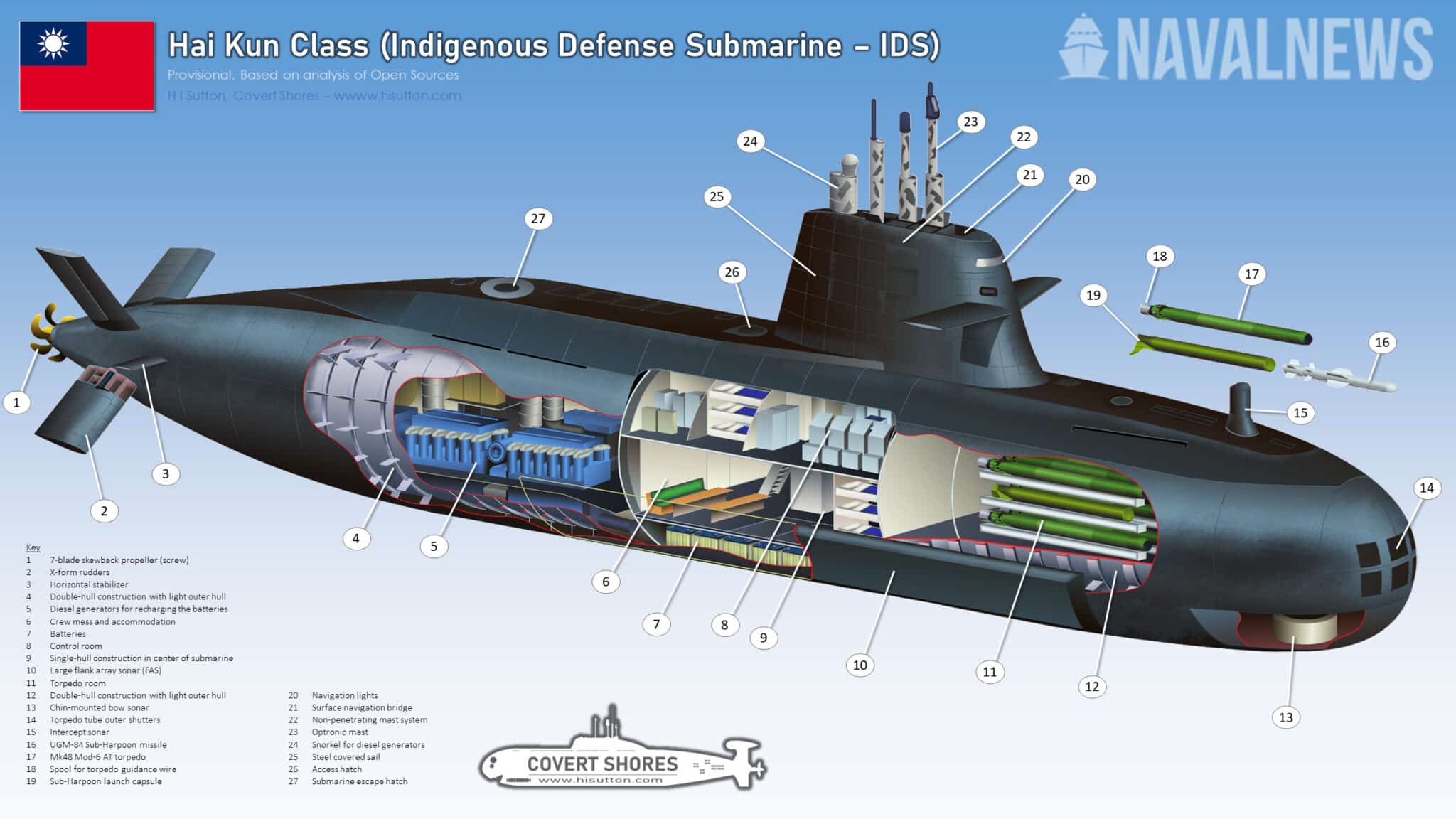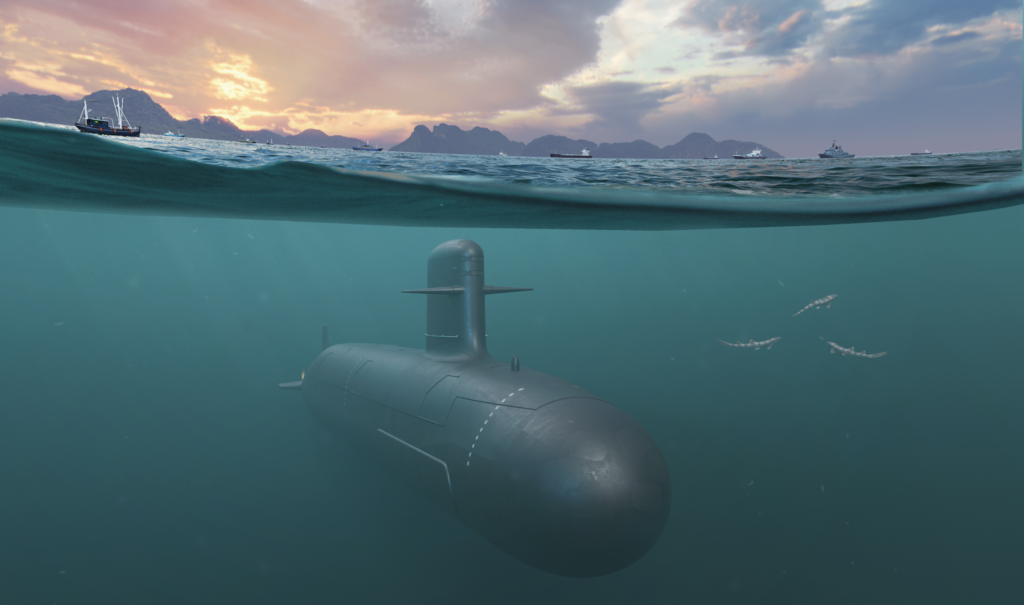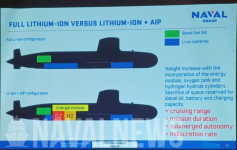Halifax Tar
Army.ca Fixture
- Reaction score
- 12,847
- Points
- 1,260
Also these times are where I don’t enjoy it.
Great movie though

Also these times are where I don’t enjoy it.
They actually sound quite analogous to a modernized Victoria-Class. Roughly the same size. Similar range, etc. They also have the bonus of being equipped with American systems.Meanwhile, in Taiwan
Notable in the final video that Canada is given some props for assisting in the development of this sub. Short range diesel-electric.

Hai Kun-class submarine - Wikipedia
en.wikipedia.org
Apparently between the 212s and the 216s. About the size of the Dutch Walrus at 2500 tonnes, may be related to the earlier Dutch Zwaardvis.
The first of eight.

The masts are supplied by L3 Harris and are expected to include electro-optical ‘periscopes’. These masts, which are similar to the ones aboard the U.S. Navy’s Virginia-class, have several advantages. They do not penetrate the hull so they are safer for the boat if it accidentally hits a ship. This happens frequently enough to be a real concern with traditional periscopes which go into the hull. When they hit something they can bend and cause leaks where they meet the hull. The new system is completely outside the hull so this will not happen.
Another advantage is that they are modular, meaning that new masts can easily be switched in or out. And the modern optics means that the periscope doesn’t have to be raised for as long, so it is less likely to be detected.
Since they already have American systems they would require less "Canadian-izing" than some of the other foreign subs being looked at.The submarine will be armed with the U.S. supplied MK-48 Mod6 Advanced Technology (AT) heavyweight torpedoes. 18 were approved for sale to Taiwan in 2020. These weapons, while not the latest model, are thoroughly modern. Their carriage will provide both anti-ship and anti-submarine capabilities.
The torpedoes are expected to be complemented by the submarine-launched version of the U.S. Navy’s famous Harpoon anti-ship missile. The UGM-84 Sub-Harpoon is already in service with Taiwan aboard the Hai Lunch-class.
The weapons are integrated into a combat management system supplied by Lockheed Martin. This is fed target data from the submarine’s primary sensor, a sonar suite supplied by Raytheon. This features a bow array below the torpedo tubes, and large flank arrays running along either side.
They actually sound quite analogous to a modernized Victoria-Class. Roughly the same size. Similar range, etc. They also have the bonus of being equipped with American systems.

America Providing Advanced Systems For Taiwan's New Submarine - Naval News
Taiwan, which has unveiled its first locally designed submarine, is relying on some key elements of American technology.www.navalnews.com
Since they already have American systems they would require less "Canadian-izing" than some of the other foreign subs being looked at.
The question is how do we plan on using our subs? If we're looking at expeditionary use then AIP and VLS equipped subs might make more sense, but if we're simply looking at patrolling our territorial waters then maybe something like this might make sense if the price was right?

This Taiwanese submarine is generally very conservative in its design, it is based off an older design with some modernized elements but it is missing some features like anechoic tiles and a more modern hull design. If Canada is going to bother with submarines, we shouldn't be attempting to cheap out. Submarines are very expensive, so you might as well get something properly worth that money.Since they already have American systems they would require less "Canadian-izing" than some of the other foreign subs being looked at.
The question is how do we plan on using our subs? If we're looking at expeditionary use then AIP and VLS equipped subs might make more sense, but if we're simply looking at patrolling our territorial waters then maybe something like this might make sense if the price was right?
and don't try to add to the design. Include the features that are deemed essential in the initial request. If it can't do what we want without changes, choose that will.This Taiwanese submarine is generally very conservative in its design, it is based off an older design with some modernized elements but it is missing some features like anechoic tiles and a more modern hull design. If Canada is going to bother with submarines, we shouldn't be attempting to cheap out. Submarines are very expensive, so you might as well get something properly worth that money.
Who would build it?OK...here's (another) silly question.
The AUKUS nuclear submarine is a new design to be used by both the UK and Australia and according to Wikipedia "will incorporate US technology such as propulsion plant systems and components, a common vertical launch system and weapons", and "will have a high degree of commonality" with the Virginia class, including "sharing elements of the propulsion plant, combat system and weapons", enhancing interoperability and Australia's transition to SSN-AUKUS"
I think we can all confidently say that Canada is not going to acquire nuclear submarines for both political and economic reasons. But would there be an opportunity for Canada to join the AUKUS submarine program to purchase a conventional version of the AUKUS SSN?
There is a president (although not a great one admittedly) for an existing nuclear submarine design to be modified to a conventional design - the Shortfin Barracuda that Australia originally was going to buy from France.
We know that whatever submarine Canada buys to replace the Victoria-Class will have US combat systems and weapons. In fact a major part of the cost of upgrading the Victoria-Class subs for use by Canada was integrating these US compatible systems. Even if we were to purchase an existing conventional submarine design from a European or Asian country there would likely be some fairly extensive "Canadian-ization" to the design required to meet our engineering standards and our desire for interoperability with US systems.
If we're going to have to pay for Canadian-ization of whatever MOTS design we buy anyway why don't we put that money into a nuclear-to-conventional Canadian-ization rather than a European/Asian Combat System/Weapons Canadian-ization? The end result for Canada is we get a conventional submarine that is broadly similar in combat capability (other than range/endurance) as our major allies. Assuming we purchase our hulls from UK yards the benefit for them is they they get a conventional submarine design that they can potentially sell to other allied nations allied with AUKUS.
Or do as the Japanese are doing and use the space where you'd have the AIP for Lithium-Ion batteries instead.At 8,000 tons you can have AIP and a enlarged battery pack.
France is going the same route with their "Scorpene Evolved" that they are offering to the Indonesian Navy.The eleventh Sōryū-class submarine (Ōryū) is the first Japanese submarine in the fleet to mount lithium-ion batteries. The JS Ōryū was given a budget of ¥64.3 billion (equivalent to ¥65.55 billion or US$601.3 million in 2019)[8] under the 2015 Japanese Defense Budget.[9]
Lithium-ion batteries have almost double the electric storage capacity of traditional lead-acid batteries, and by not only replacing them in the existing battery storage areas but adding to the already large battery capacity by also filling the huge space (several hundred tons displacement) inside the hull previously occupied by the AIP Stirling engines and their fuel tanks with these new batteries, the amount of (more powerful) batteries carried overall is massive. This has improved the underwater endurance significantly and is felt will be an advantage over the slow recharge capability of the AIP system.
In any event, JMSDF believes that lithium-ion is the way forward and intends to 'trial' this new system and compare it to the previous AIP system for operational effectiveness.


Who makes one that big?At 8,000 tons you can have AIP and an enlarged battery pack.
Okay I’m tracking now.The AUKUS boats are smaller than the Block V VA’s, but apparently similar to the earlier blocks at around 8k tons.
I was quoting you. If you built a conventional sub in that tonnage you have a lot of room to work with.
| Type | Class | Builder | Displacement Tonnes |
| Ballistic missile submarines[edit] | Borei class (Project 955 Borey) | Russia | 24,000 |
| Ballistic missile submarines[edit] | Ohio class (SSBN-726) | United States | 18,750 |
| Ballistic missile submarines[edit] | Delta class (Project 667BDR Kal'mar / 667BDRM Del'fin) | Soviet Union / Russia | 18,200 |
| Ballistic missile submarines[edit] | Vanguard class | United Kingdom | 15,900 |
| Ballistic missile submarines[edit] | Triomphant class | France | 14,335 |
| Ballistic missile submarines[edit] | Jin class (Type 094) | People's Republic of China | 11,000 |
| Ballistic missile submarines[edit] | Xia class | People's Republic of China | 8,000 |
| Ballistic missile submarines[edit] | Arihant class (Project ATV) | India | 7,000 |
| Cruise missile submarines[edit] | Oscar class (Project 949 Granit/Project 949A Antey) | Soviet Union / Russia | 19,400 |
| Cruise missile submarines[edit] | Ohio class (Tactical Trident) | United States | 18,750 |
| Cruise missile submarines[edit] | Yasen class | Russia | 13,800 |
| Cruise missile submarines[edit] | Shang class (Type 093G) | People's Republic of China | 7,000 |
| Nuclear-powered attack submarines[edit] | Akula class (Project 971 Shchuka) | Soviet Union / Russia | 13,800 |
| Nuclear-powered attack submarines[edit] | Sierra class (Project 945) | Soviet Union / Russia | 10,400 |
| Nuclear-powered attack submarines[edit] | Virginia class Block V | United States | 10,200 |
| Nuclear-powered attack submarines[edit] | Seawolf class (SSN-21) | United States | 9,300 |
| Nuclear-powered attack submarines[edit] | Shang class (Type 093) | People's Republic of China | 8,000 |
| Nuclear-powered attack submarines[edit] | Virginia class Block I-IV | United States | 7,900 |
| Nuclear-powered attack submarines[edit] | Astute class | United Kingdom | 7,400 |
| Nuclear-powered attack submarines[edit] | Victor class | Soviet Union / Russia | 7,250 |
| Nuclear-powered attack submarines[edit] | Los Angeles class (SSN-688) | United States | 7,000 |
| Nuclear-powered attack submarines[edit] | Barracuda class | France | 5,300 |
| Nuclear-powered attack submarines[edit] | Trafalgar class | United Kingdom | 5,208 |
| Nuclear-powered attack submarines[edit] | Han class (Type 091) | People's Republic of China | 4,500 |
| Nuclear-powered attack submarines[edit] | Rubis class | France | 2,670 |
| AIP Submarines | Qing-class submarine | China | 6,628 |
| AIP Submarines | Sōryū class | Japan | 4,200 |
| AIP Submarines | Yuan class | China | 3,600 |
| AIP Submarines | S-80 Plus class | Spain | 3,426 |
| AIP Submarines | Type 212C/D class | Germany/Italy | 2,500 |
| AIP Submarines | Type 214 submarine | Germany | 1,980 |
| AIP Submarines | Dolphin class (Dolphin-2; AIP-variant) | Germany | 1,900 |
| AIP Submarines | Type 212A class | Germany/Italy | 1,830 |
| AIP Submarines | Blekinge class | Sweden | 1,800 |
| AIP Submarines | Agosta-90B class | France | 1,725 |
| AIP Submarines | Gotland class | Sweden, | 1,647 |
| AIP Submarines | Scorpène class | France/Spain | 1,590 |
| AIP Submarines | Västergötland class / Archer class | Sweden | 1,145 |
| Diesel Electric | Taigei class | Japan | 4,300 |
| Diesel Electric | Oyashio class | Japan | 4,000 |
| Diesel Electric | Kilo class (Project 877 Paltus and Project 636) | USSR/Russia | 3,100 |
| Diesel Electric | Collins class | Australia | 3,050 |
| Diesel Electric | Walrus class | Netherlands | 2,800 |
| Diesel Electric | Lada class (Project 677 Lada) | Russia | 2,700 |
| Diesel Electric | Zwaardvis class | Netherlands | 2,600 |
| Diesel Electric | Victoria class (SSK 876) | UK | 2,400 |
| Diesel Electric | Song class | China | 2,250 |
| Diesel Electric | TR-1700 class | Germany | 2,116 |
| Diesel Electric | Ming class (Type 035) | China | 2,100 |
| Diesel Electric | Sinpo class | North Korea | 2,000 |
| Diesel Electric | Dolphin class (Dolphin-1; non-AIP variant) | Germany | 1,900 |
| Diesel Electric | Agosta class | France / Spain | 1,725 |
| Diesel Electric | Sauro class | Italy | 1,653 |
| Diesel Electric | Type 209 submarine | Germany | 1,586 |
| Diesel Electric | Nagapasa class | South Korea/Indonesia | 1,400 |
| Diesel Electric | Type 209 submarine | Germany | 1,290 |
| Diesel Electric | Type 209 submarine | Germany | 1,230 |
| Diesel Electric | Challenger class (ex-Sjöormen class) | Sweden | 1,210 |
| Diesel Electric | Ula class (Type 210) | Germany | 1,150 |
| Diesel Electric | Fateh class | Iran | 593 |
| Diesel Electric | Type 206 submarine | Germany | 500 |
| Diesel Electric | Sang-O class | North Korea | 370 |
| Midgets | Nahang class | Iran | 400 |
| Midgets | Yono class | North Korea | 130 |
| Midgets | Ghadir class | Iran | 115 |
| Midgets | Yugo class | North Korea | 110 |
| Specials | Belgorod (K-329) | Russia | 30000 |
| Specials | Sarov (B-90) | Russia | 4000 |
| Specials | Uniform-class special mission submarine (Project 1910 Kashalot) | Russia | 1580 |
| Specials | Paltus-class special mission submarine (Project 1083.1) | Russia | 730 |
| Specials | Losharik | Russia | 200 |
| Specials | NSRS Deep submergence rescue vehicle | UK | 41 |
| Specials | Mystic-class deep sea rescue submersible (DSRV-1) | US | 37 |
| Specials | LR5 Deep submersible | UK | 21 |
| Specials | Al-Sabehat swimmer delivery vehicle | Iran | |
| Specials | VAS 525 mini-submarine | Italy | |
| XLUUV | Orca | US | 45 |
| XLUUV | Cebus | UK | 17 |
I would look closely at one of the primary issues of that design, the complexity and risk taken on by the RAN. Modifying a nuclear submarine into a conventional submarine is incredibly difficult, that's even before Australia wanted it to be full of domestic and American systems/weaponry. The design was an integration nightmare and should be something we stay as far away from as humanly possible. Submarines are incredibly complex platforms, the effort would not be worth the result you would get from trying to convert the AUKUS SSN design into a conventional boat.There is a president (although not a great one admittedly) for an existing nuclear submarine design to be modified to a conventional design - the Shortfin Barracuda that Australia originally was going to buy from France.
The UK and US are basically at capability with their own orders plus the Australian SSN orders. Canada is going to be forced to look elsewhere in Europe or Asia for a partner to build any conventional submarines for them.I’m unsure of British shipyard capacity, but I tend to doubt the willingness of either UK or US yards to build a hybrid for Canada simply because Canada is an unreliable Defense partner for major programs.
My prediction is either the KSS-III or the Type 212CD. The German design is incredibly cutting edge with a proven builder behind it while the KSS-III is a larger boat with more options available (VLS, lithium ion batteries, suite of new Korean missile systems) and backed by a nation that has aggressive export marketing/capability to build.still think I prefer a KSS-III option due to
technologically advanced
continuous build via two shipyards
SK apparent ability to work with other nations at closing deals
however it will be interesting to see which choice the Dutch go with late this year/early next year
A26 Sweden
U212CD Germany
Barracuda France
Too bad the Nuke Barracuda wasnt an option for the Australian sub but I guess that relationship was unrecoverable
I would normally agree for the Dutch but considering how heavily Saab and Damen seem to be partnered for the A26 bid, I wouldn't count them out. They seem to have a fairly robust plan for domestic Dutch work and upkeep on these boats, doing assembly and many other tasks domestically. As far as I know, the Germans have not offered such a thing.If I were a betting man I would say that the Dutch are going with the U212CD. Norway and Germany are both getting those. Honestly I like the KSS-III as the options it brings to Canada, but the U212CD is very interesting.


